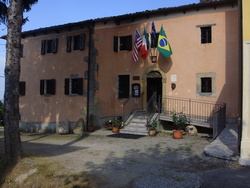Iola today is a small village within the municipality of Montese. Once belonged to Monteforte, famous in the past because was situated, with its castle and fortress, on the borderland between the Dukedom of Modena and the Papal States to which Bologna belonged. The Monteforte area has always been a place of conflicts and incursions from both sides, as is amply testified by place names such as Malandrone, Ore Buie and Malavolta, (Dark Hours and Unlucky Time) which are found scattered along the divide.
When the castle was destroyed and abandoned at the beginning of the 17th century (ca 1630s) a part of its territory given over to the sattlement of Maserno, and the other part gave origin to Jola. Previously known as Malavolta, Iola also began life as a parish during this period.
 At that time, in 1683s, the building was used as a vicarage of Parish Church. Over the years it underwent several works of conservation, starting with that of 1728s, due to the state of disrepair it into a had fallen because the parish priests of the time, all from Jola preferred to reside in their family homes. The stone entrance portal was restored in 1855s, and the kitchen fireplace, also stone, in 1905s.
At that time, in 1683s, the building was used as a vicarage of Parish Church. Over the years it underwent several works of conservation, starting with that of 1728s, due to the state of disrepair it into a had fallen because the parish priests of the time, all from Jola preferred to reside in their family homes. The stone entrance portal was restored in 1855s, and the kitchen fireplace, also stone, in 1905s.
During the 2nd World War, whereas the bell tower was almost undamaged, the adjoining church was destroyed, and the vicarage, althought damaged, continued to be inhabited by the parish priest. Both the church and vicarage were rebuilt in 1950s. The latter was used initially for some primary school classrooms and then abandoned for several decades, becoming derelict and unsafe.

At 1990, the cultural group "Il Trebbo" along with the parish priest, decided to salvage the building and make it a "Collection of items from Montese" museum. The time-consuming of the difficult renovation, coordinated with enthusiasm, commitment and competence by the priest of the time, Don Fabrizio Martelli, were completed thanks to the generosity of different organizations and individuals also to the voluntary cooperation of Montese's inhabitants sympathizers.
 These rooms housed objects documents and personal accounts of territory, therefore, an expression of cultural heritage, acquired through the loans or spontaneous donations of residents and assiduous guests of the village.
These rooms housed objects documents and personal accounts of territory, therefore, an expression of cultural heritage, acquired through the loans or spontaneous donations of residents and assiduous guests of the village.
The criteria used in the display of the material are as follows:
- recreate the various living styles and environments: kitchen, bedroom, cellar, agricultural implements, stable, mill, carpentry, cobbler, loom;
- give an account of the geological origins of our mountains, both mineral and fossil;
- display objects and documentation regarding an exceptionally dramatic period in the history of our people: the War.
The visit may follow two educational strands:
- direct observation of the objects and implements which made up the furnishings of the environments with an analysis and description of their use,
-evolution of a particular theme, e.g. the story of wheat: plowing - sowing – harvesting – storing (sheaving and binding) – milling – usage.
In the year 2004, also thanks to the Andrea e Giuliano Gandolfi brothers, two more rooms were added - to date the exhibition occupies the entire first floor - for accommodate items dating back to the Second World War period. The items were classified according to the Army, so can admire weapons, uniforms and everyday objects once belonging to Wehrmacht soldiers, Brazilians of FEB, 10th Mountain Division soldiers and one room was dedicated to Italian Memories.

In more recent years, between 2009 and 2010, the Museum underwent extension works which added to the facility the old stable and barn, connecting them directly to the main premises in the vicarage.
Also the underlying basement was converted to offer visitors a number of theme rooms created in an original period context.
In the year 2012 the work was completed with the removal of architectural barriers aimed to the usability of museum environments to the disabled.
 In the year 2010 the museum was recognized as MUSEUM OF QUALITY by the Institute for Artistic, Cultural and Historical assets of Emilia Romagna Region
In the year 2010 the museum was recognized as MUSEUM OF QUALITY by the Institute for Artistic, Cultural and Historical assets of Emilia Romagna Region












